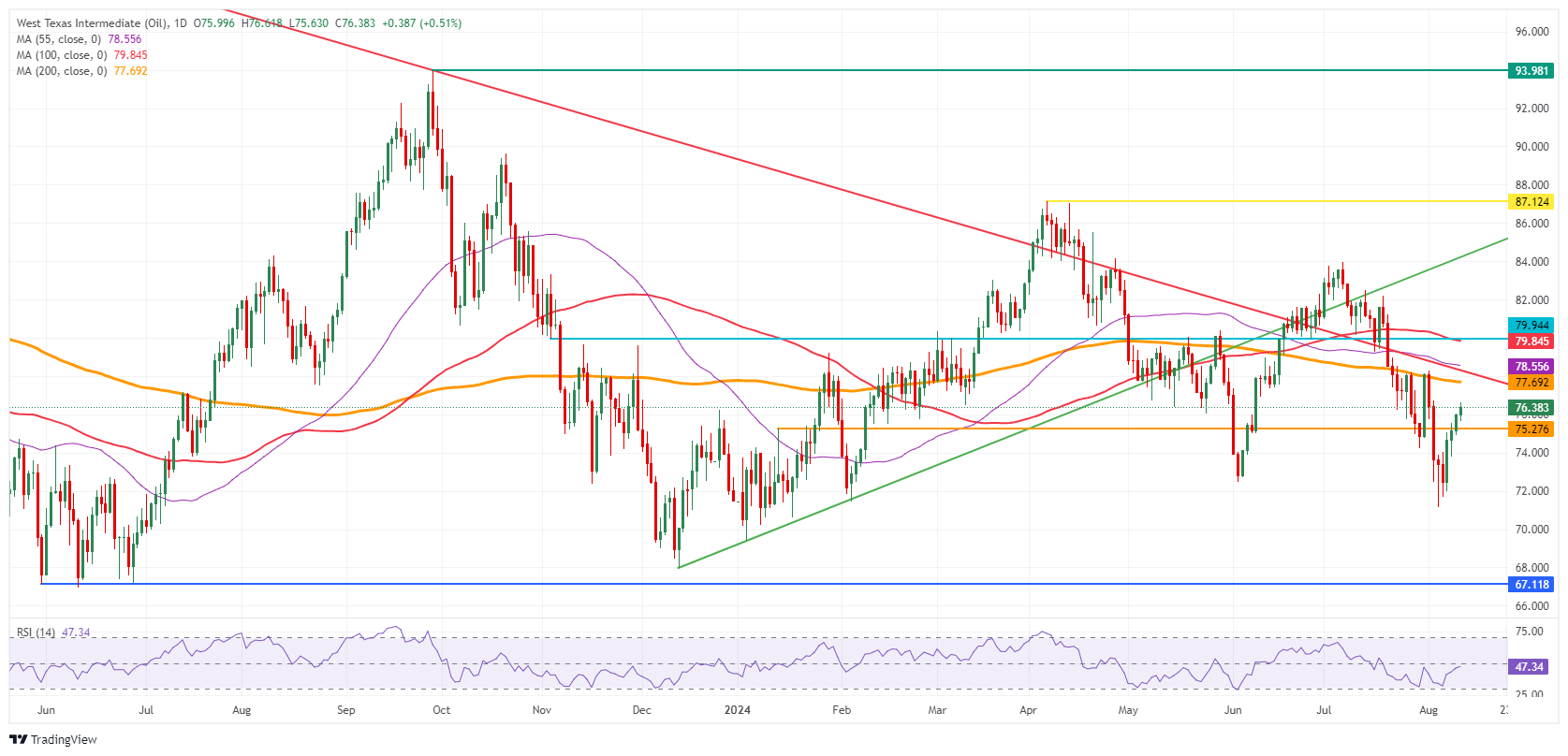Oil pops with elevated risk towards the upcoming OPEC production meeting after sluggish report outlook

- Oil price jumps higher for a fourth consecutive day on Monday.
- Traders send Oil prices higher on trimmed demand outlook from OPEC.
- The US Dollar Index trades at a pivotal level after being glued to it since last week.
Oil price jumps higher for a fourth straight day in a row on Monday. Oil traders are sending Crude prices higher after the Organization of the Petroleum Exporting Countries (OPEC) his trimmed its demand outlook and might limit production in its upcoming meeting. Certainly, seeing recent price increases from Saudi Arabia towards Asia and Russia set to commit to its production quota by firmly reducing its production over August and September. Volatility is bound to pick up with the report from the International Energy Administration (IEA) on Wednesday, which is often a bit more dovish than the OPEC one.
The US Dollar Index (DXY), which tracks the performance of the US Dollar against six major currencies, is still having issues and trades near the pivotal level it was residing around in the aftermath of the rough Monday ride in markets last week. It looks like the DXY will orbit around this level until the first catalyst, which will probably be the US Consumer Price Index (CPI) print for July scheduled for Wednesday. Should that report reveal a pickup in inflation, market repricing would favor a stronger US Dollar.
At the time of writing, Crude Oil (WTI) trades at $76.75 and Brent Crude at $80.1
Oil news and market movers: Risk Premium
- OPEC lowered projections for world demand growth in 2024 by 135,000 barrels a day in its monthly outlook report, Reuters reports.
- Bloomberg reports that US refiners are set to reduce production, with the biggest producer reporting to operate its plants at only 90% capacity. That level is the lowest since 2020.
- Saudi Aramco is providing nearly 2 million barrels less in September than it will do for August, Reuters reports.
- Although headlines from the Middle East have moved a bit to the background, tensions are still present, and the element still needs to be factored in as a tail risk for more upside.
Oil Technical Analysis: Against all odds
Oil price is rallying higher, with several traders having bought the dip that took place last week. Expect this move to start fading slowly but surely under pressure from profit-taking along the way. The OPEC and IEA report could be the catalyst for that turnaround, together with possible price action turning just ahead or at the 200-day Simple Moving Average near $77.69.
On the upside the pivotal level near $75.27 has now been reclaimed by bulls, which now will act as support level to head back to the 200-day Simple Moving Average (SMA) at $77.69. The two other major moving averages reside very close, with the 55-day SMA at $78.55 and the 100-day SMA at $79.84.
The Relative Strength Index (RSI) has rebounded in the daily chart, meaning there is room again to trend lower. Looking down, the first level to watch out for is $72.00. Once a new low for August gets printed in the charts, another leg lower would not rule out $68.00 or even $67.11, an 18-month low.
US WTI Crude Oil: Daily Chart
WTI Oil FAQs
WTI Oil is a type of Crude Oil sold on international markets. The WTI stands for West Texas Intermediate, one of three major types including Brent and Dubai Crude. WTI is also referred to as “light” and “sweet” because of its relatively low gravity and sulfur content respectively. It is considered a high quality Oil that is easily refined. It is sourced in the United States and distributed via the Cushing hub, which is considered “The Pipeline Crossroads of the World”. It is a benchmark for the Oil market and WTI price is frequently quoted in the media.
Like all assets, supply and demand are the key drivers of WTI Oil price. As such, global growth can be a driver of increased demand and vice versa for weak global growth. Political instability, wars, and sanctions can disrupt supply and impact prices. The decisions of OPEC, a group of major Oil-producing countries, is another key driver of price. The value of the US Dollar influences the price of WTI Crude Oil, since Oil is predominantly traded in US Dollars, thus a weaker US Dollar can make Oil more affordable and vice versa.
The weekly Oil inventory reports published by the American Petroleum Institute (API) and the Energy Information Agency (EIA) impact the price of WTI Oil. Changes in inventories reflect fluctuating supply and demand. If the data shows a drop in inventories it can indicate increased demand, pushing up Oil price. Higher inventories can reflect increased supply, pushing down prices. API’s report is published every Tuesday and EIA’s the day after. Their results are usually similar, falling within 1% of each other 75% of the time. The EIA data is considered more reliable, since it is a government agency.
OPEC (Organization of the Petroleum Exporting Countries) is a group of 13 Oil-producing nations who collectively decide production quotas for member countries at twice-yearly meetings. Their decisions often impact WTI Oil prices. When OPEC decides to lower quotas, it can tighten supply, pushing up Oil prices. When OPEC increases production, it has the opposite effect. OPEC+ refers to an expanded group that includes ten extra non-OPEC members, the most notable of which is Russia.
